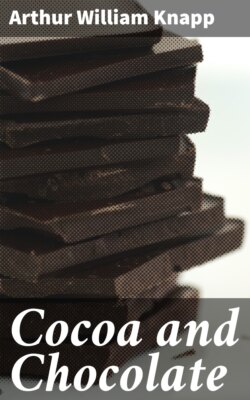Читать книгу Cocoa and Chocolate - Arthur William Knapp - Страница 13
На сайте Литреса книга снята с продажи.
First Cacao in Europe.
ОглавлениеTable of Contents
The Spanish discoverers of the New World brought home to Spain quantities of cacao, which the curious tasted. We may conclude that they drank the preparation cold, as Montezuma did, hot chocolate being a later invention. The new drink, eagerly sought by some, did not meet with universal approval, and, as was natural, the most diverse opinions existed as to the pleasantness and wholesomeness of the beverage when it was first known. Thus Joseph Acosta (1604) wrote: "The chief use of this cocoa is in a drincke which they call Chocholaté, whereof they make great account, foolishly and without reason; for it is loathsome to such as are not acquainted with it, having a skumme or frothe that is very unpleasant to taste, if they be not well conceited thereof. Yet it is a drincke very much esteemed among the Indians, whereof they feast noble men as they passe through their country. The Spaniards, both men and women, that are accustomed to the country are very greedy of this chocholaté." It is not impossible that the English, with the defeat of the Armada fresh in memory, were at first contemptuous of this "Spanish" drink. Certain it is, that when British sea-rovers like Drake and Frobisher, captured Spanish galleons on the high seas, and on searching their holds for treasure, found bags of cacao, they flung them overboard in scorn. In considering this scorn of cacao, shown alike by British buccaneers and Dutch corsairs, together with the critical air of Joseph Acosta, we should remember that the original chocolatl of the Mexicans consisted of a mixture of maize and cacao with hot spices like chillies, and contained no sugar. In this condition few inhabitants of the temperate zone could relish it. It however only needed one thing, the addition of sugar, and the introduction of this marked the beginning of its European popularity. The Spaniards were the first to manufacture and drink chocolate in any quantity. To this day they serve it in the old style—thick as porridge and pungent with spices. They endeavoured to keep secret the method of preparation, and, without success, to retain the manufacture as a monopoly. Chocolate was introduced into Italy by Carletti, who praised it and spread the method of its manufacture abroad. The new drink was introduced by monks from Spain into Germany and France, and when in 1660 Maria Theresa, Infanta of Spain, married Louis XIV, she made chocolate well known at the Court of France. She it was of whom a French historian wrote that Maria Theresa had only two passions—the king and chocolate.
Chocolate was advocated by the learned physicians of those times as a cure for many diseases, and it was stated that Cardinal Richelieu had been cured of general atrophy by its use.
From France the use of chocolate spread into England, where it began to be drunk as a luxury by the aristocracy about the time of the Commonwealth. It must have made some progress in public favour by 1673, for in that year "a Lover of his Country" wrote in the Harleian Miscellany demanding its prohibition (along with brandy, rum, and tea) on the ground that this imported article did no good and hindered the consumption of English-grown barley and wheat. New things appeal to the imaginative, and the absence of authentic knowledge concerning them allows free play to the imagination—so it happened that in the early days, whilst many writers vied with one another in writing glowing panegyrics on cacao, a few thought it an evil thing. Thus, whilst it was praised by many for its "wonderful faculty of quenching thirst, allaying hectic heats, of nourishing and fattening the body," it was seriously condemned by others as an inflamer of the passions!
